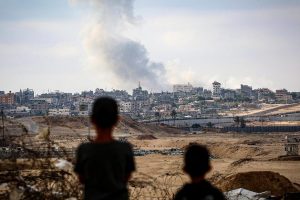
On Thursday evening, a Telegram account belonging to Ukrainian military intelligence reported that Russian forces were decreasing around the Zaporizhzhia Nuclear Plant. Rosatom employees brought in from Russia were reportedly the first to depart, soldiers in the area were being reassigned elsewhere, and Ukrainian workers at the plant were warned to get away.
The Ukrainian military followed up on Friday morning, indicating that both plant personnel and Russian military forces in the area were departing. They also indicated that Ukraine had performed nuclear disaster drills in the area.
Russia has reportedly given a deadline of July 5 for its forces to be out of the area, which is once again creating worries that Vladimir Putin is about to take drastic action to slow Ukraine’s counteroffensive.
Zaporizhzhia Nuclear Power Plant
Russia captured the Zaporizhzhia plant just over a week after Russian forces crossed the border into Ukraine. That capture came after a spectacular, and terrifying, sequence of events in which fighting at the nuclear facility was visible around the world in video from Enerhodar residents and local security cameras.
Since Russia took control of the plant, there have been numerous occasions on which disaster—ranging from a controlled loss of the plant to a massive discharge of radioactive material across the surrounding area—has seemingly been near. That includes occasions where Russia has reportedly loaded the plant with explosives, shelled the plant themselves, and cut electrical lines necessary to the plant’s stability. Just over a month ago, Ukraine warned that Russia was preparing to create an “accident” at the plant.
In that last month, Russia has blown up the Kakhovka Dam, resulting in an enormous change in the center of Ukraine. The Dnipro Reservoir formerly covered an area over 2,100 kilometers and in some places was over 20 km wide. It’s now largely gone.
One of the results of the dam being lost was that the pipes at the Zaporizhzhia NPP no longer reach the river to provide cooling water. This also placed the cooling pool for the plant at risk of collapse. An international safety organization reported that “the loss of the pool would not necessarily be catastrophic as other sources of water could be brought in, such as pumping trucks, to prevent a meltdown of the plant’s nuclear fuel, but a loss of the cooling pool would dramatically increase safety concerns at the plant.”
The current status of that cooling pool isn’t known. It’s also not known if Russia has made any effort to see that other sources of water were brought in.
Earlier concerns about Zaporizhzhia NPP have led to multiple analyses of the consequences of a failure, either by accident or through sabotage, and how it might compare to the Chernobyl disaster in northern Ukraine. Though the design of Zaporzhzhia is intrinsically safer than that of the reactor that failed disastrously at Chernobyl, there are concerns that its integrity may have been damaged by months of shelling in the area, or that Russia might have intentionally created conditions to worsen any failure.
A report from the IAEA compiled shortly after their inspectors had first visited the site was not reassuring: “Any further escalation affecting the six-reactor plant could lead to a severe nuclear accident with potentially grave radiological consequences for human health and the environment in Ukraine and elsewhere.”
Any accident at the plant could easily force Ukraine to evacuate citizens from a broad area, including the city of Zaporizhzhia (pop. 750,000) that lies 50 km northeast of the plant. Such an evacuation would be difficult in peacetime, but it would be a nightmare in the current circumstances, particularly if Russia used the evacuation as a chance to either direct missiles into masses of civilians or to launch fresh offensives while Ukraine was busy trying to get people out of the hot zone.
It’s difficult to know just how seriously to take this threat. This is far from the first time that such concerns have been raised about the Zaporizhzhia Nuclear Power Plant. It’s not even the first time such concerns have appeared in an official statement from Ukrainian military intelligence.
However, the destruction of the Kakhovka Dam shows that Russia is more than willing to cause immense environmental destruction and a massive human catastrophe to protect its invasion efforts.
If they did that, it’s hard to say they would not take an even more significant step. Besides, no matter how many times someone shouts about a nuclear wolf, ignoring the threat just seems like a bad idea.
Antonivka Bridge
It’s difficult to believe the small Ukrainian position established on the east bank of the Dnipro River across from Kherson will turn into any kind of genuine push to regain territory in this region. Without any kind of functional bridge, and with Russian artillery in range of any pontoon bridge that might be established, it seems unlikely that what Ukraine has shuttled across the river on barges represents a force sufficient to move much beyond their literal bridgehead in the shadow of the Antonivka Bridge.
However, even this small group sure does seem to be making a pest of itself. In addition to fighting with Russian forces along the road to Oleshky, the Ukrainian troops seem stubbornly hard to push back across the river.
On Friday, Russia took a break from shelling the Ukrainian position long enough to hit the Ukrainian base with a pair of Iskander short-range ballistic missiles. The “short range” in this case is in ballistic missile terms, as this weapon is still good for about 500 km. It’s likely that this pair was fired from somewhere well down in Crimea, Each of the missiles carries a high explosive warhead massing between 700 and 800 kg.
However, following the strike the Ukrainian base still appears to be up and active, with both men and machines visibly moving about. Either the Iskanders missed, or the Ukrainian forces are really dug in well at their bridgehead position.
It appears that Russia made another attempt to regain control of things along the Kherson waterfront using a different method. That one also did not go well. (Trigger warning for very visible violence against individuals.)
Ukraine’s ability to maintain this position so far is astounding, but if the Antonivka bridgehead is going to do more than absorb Russian attacks, Ukraine is going to need a way to reinforce this position and to establish other such bridgeheads along the “left” bank of the Dnipro.
Southern Ukraine front
For those who have itchy “come on, I want to put more blue on the map!” fingers, progress in southern Ukraine continues to be frustratingly slow. However, most of what’s happening seems to be good news.

Ukrainian forces are reported to be on the outskirts of Robotyne after three weeks of hard fighting. This is the same area where Leopard tanks were lost in the first days of the counteroffensive, but it seems that Ukrainian troops have largely penetrated the extensive minefield in this area and are continuing to advance.
Now that they’ve taken Rivnopil, Ukrainian forces are reportedly pressing south from that location as well as from the town of Makarivka, which was liberated last week. That’s allowing Ukraine to hit the town of Staromaiorske from two directions as the movement south of Velyka Novosilka continues. This remains the largest area of Ukrainian progress so far since the first of the month.
There’s more mixed news at Pyatykhatky where images show a Ukrainian tank (a T-72, not a Western tank) being taken out along the approach to Zherebyanky. Ukraine appears to control more area both west and south of Pyatykhatky, but movement here is definitely slow as fighting along the same small stretch of road continues.
Bakhmut area
There are conflicting narratives going on right now about what’s happening south of the city. Multiple accounts report continued Ukrainian progress at both Klishchiivka and Kurdyumivka, with Ukrainian forces either at the outskirts, or in partial control, of both towns. But one usually reputable account is reporting Progress with a capital “P,” as in Ukraine clearing the minefields along the canal, reaching Klishchiivka, and pushing Russia rapidly back.

Supporting that narrative is news that Ukraine has captured an entire Russian airborne company that was formerly stationed between the canal and Klishchiivka, reportedly because the Ukrainian forces moved into the area before Russia could evacuate.
If reports about the speed of movement in this area are accurate, the map to the south of the city should look significantly different in the next few days.
Further south at Kurdyumivka, Ukrainian forces are reportedly working their way through the town after planting a flag on the water works at the western edge on Thursday. You can tell that the fight here has been carried out over several days, but is now hitting the point where Russian forces have stepped back, because the Ukrainian troops have had time to edit and produce a video of the fight leading up to the town. (This one gets another trigger warning for close-up personal violence.)
On the north side of Bakhmut, Ukraine continues to make progress around Yahidne and in the city east of Khromove. But fighting is also going on at the northern end of what remains of the Russian salient along the M03 highway.
That fighting includes what appears to be a stock T-62 driving along the road through Zaliznyanske. That Russia has cracked out these rusty old tanks in the area around Bakhmut tells you how far down in the barrel they are reaching. Also this one seems to have forgotten about mines it had just finished laying.
What kind of day has it been for Ukraine? This kind of day:
Okay, so Russia didn’t lose 17 tanks in a day, but even in terms of equipment lost over several days that is just not getting tallied, that’s a lot of Russian rolling stock that has stopped rolling.









